Abstract
Aromatic monocarboxylic acids are known to significantly potentiate the mechanical response of skeletal muscle fibers. In this study we investigated the effects of enantiomers of 2-(4-chlorophenoxy)propionic acid, chemically one of the simplest aromatic monocarboxylic acids with chiral properties, on mechanical threshold and charge movement in frog skeletal muscle. The R(+), but not the S(-), enantiomer lowered rheobase mechanical threshold and shifted charge movement to more negative potentials. The R(+) enantiomer also significantly slowed charge movement kinetics, with pronounced delays of the OFF charge transitions. These effects required high temperature for their production. The stereospecific actions of the R(+) enantiomer are interpreted in terms of a specific interaction of this compound at an anion-sensitive site involved in excitation-contraction coupling, most likely on the dihydropryidine-sensitive voltage sensor in the T-system.
Full text
PDF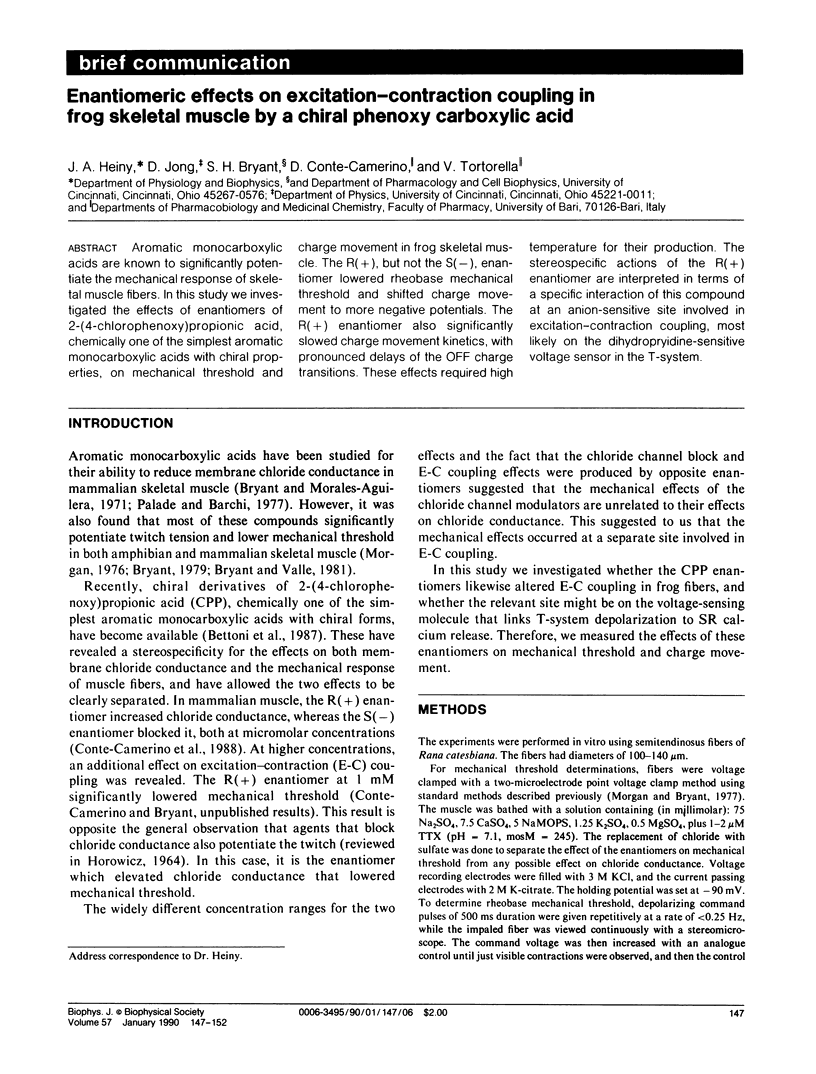
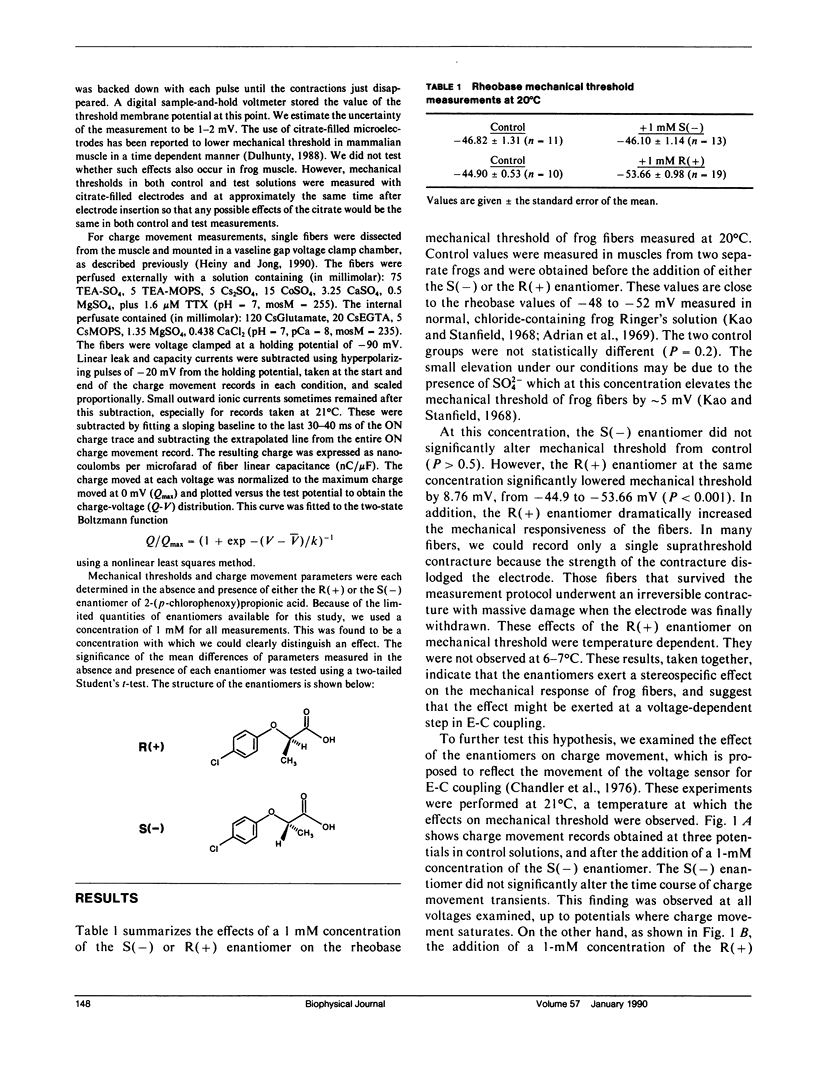
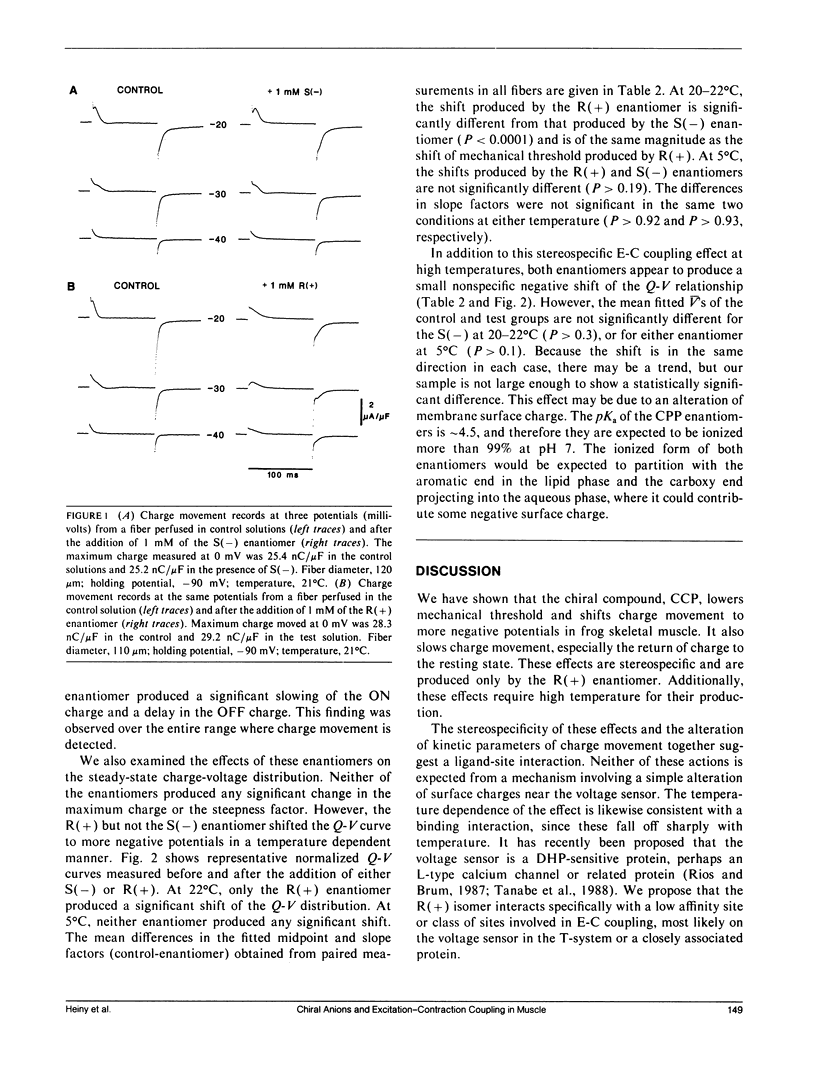
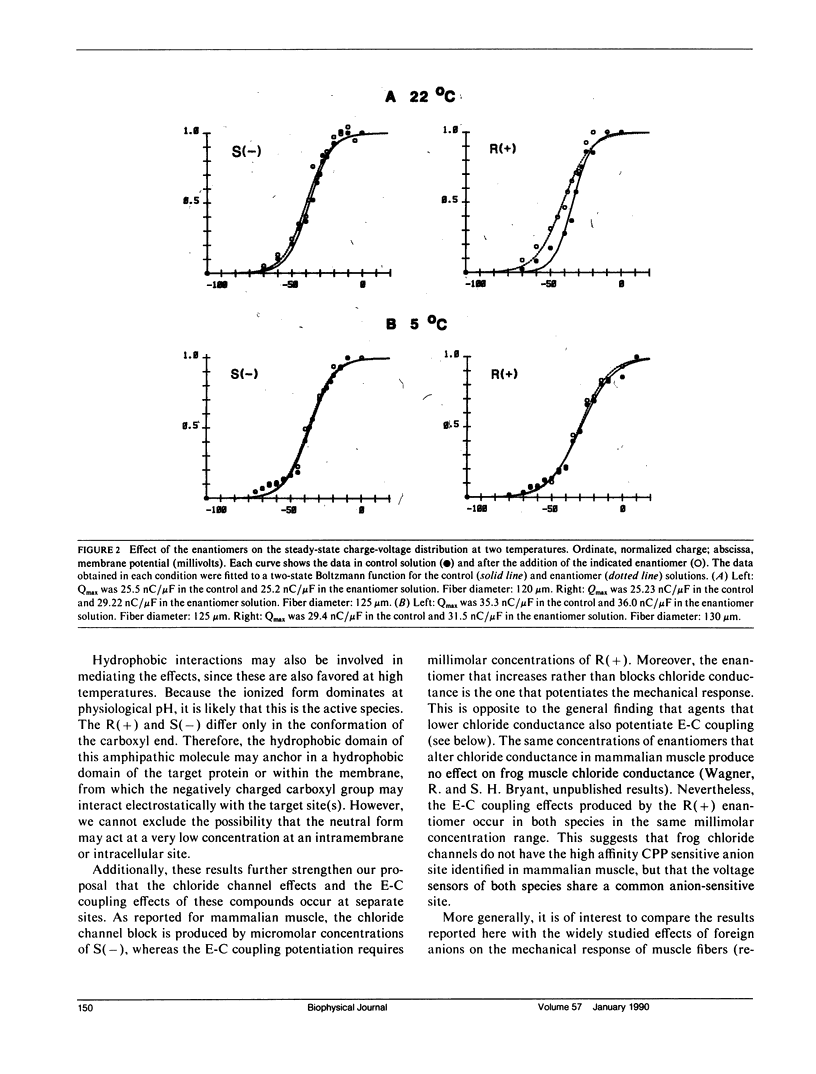
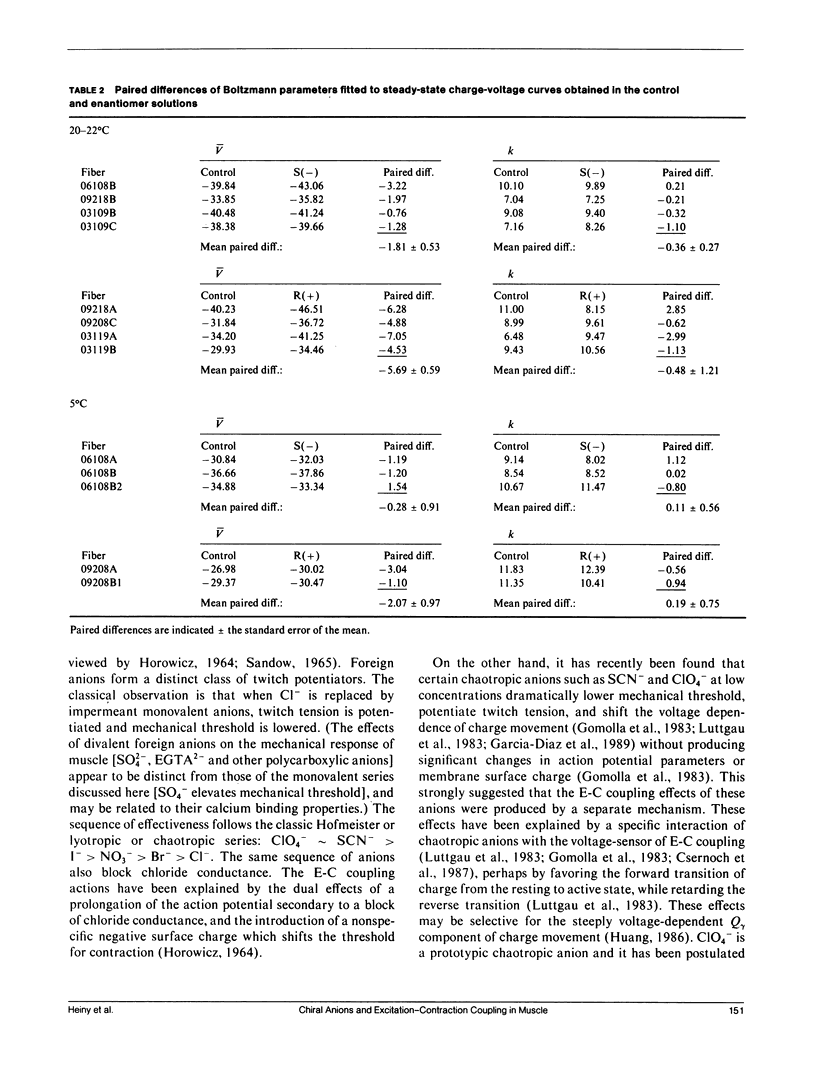
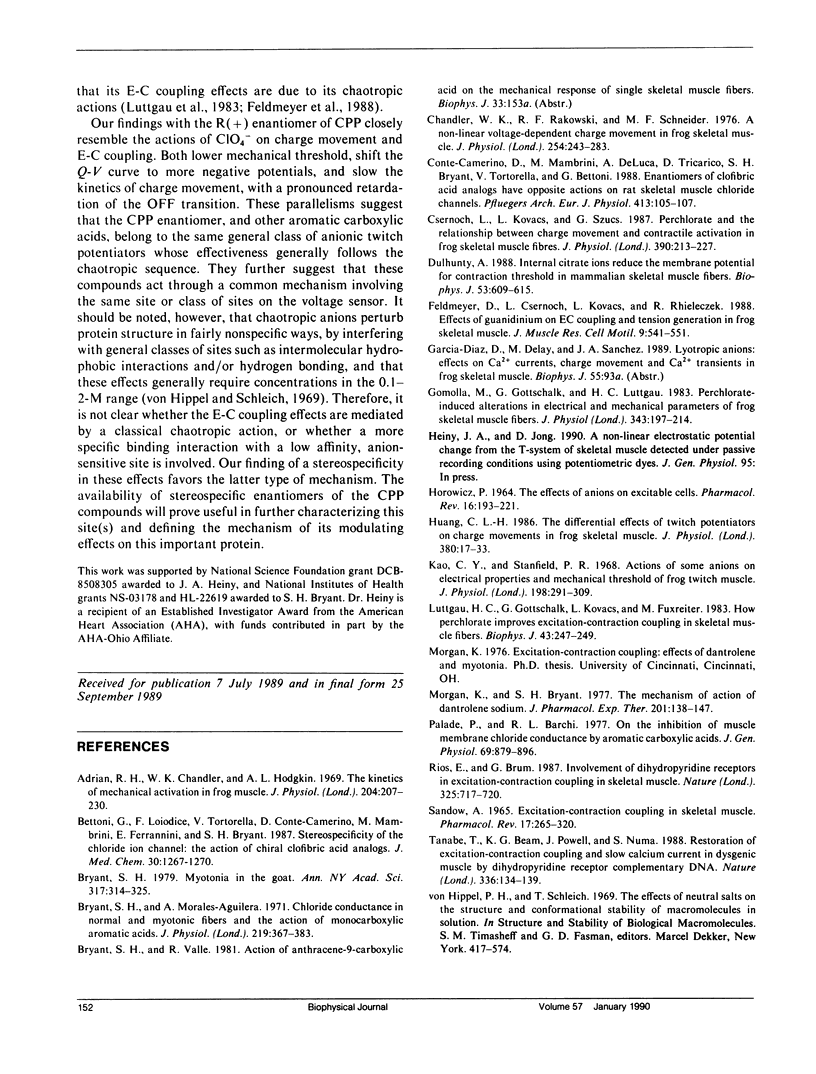
Selected References
These references are in PubMed. This may not be the complete list of references from this article.
- Adrian R. H., Chandler W. K., Hodgkin A. L. The kinetics of mechanical activation in frog muscle. J Physiol. 1969 Sep;204(1):207–230. doi: 10.1113/jphysiol.1969.sp008909. [DOI] [PMC free article] [PubMed] [Google Scholar]
- Bettoni G., Loiodice F., Tortorella V., Conte-Camerino D., Mambrini M., Ferrannini E., Bryant S. H. Stereospecificity of the chloride ion channel: the action of chiral clofibric acid analogues. J Med Chem. 1987 Aug;30(8):1267–1270. doi: 10.1021/jm00391a002. [DOI] [PubMed] [Google Scholar]
- Bryant S. H., Morales-Aguilera A. Chloride conductance in normal and myotonic muscle fibres and the action of monocarboxylic aromatic acids. J Physiol. 1971 Dec;219(2):367–383. doi: 10.1113/jphysiol.1971.sp009667. [DOI] [PMC free article] [PubMed] [Google Scholar]
- Bryant S. H. Myotonia in the goat. Ann N Y Acad Sci. 1979;317:314–325. doi: 10.1111/j.1749-6632.1979.tb56540.x. [DOI] [PubMed] [Google Scholar]
- Chandler W. K., Rakowski R. F., Schneider M. F. A non-linear voltage dependent charge movement in frog skeletal muscle. J Physiol. 1976 Jan;254(2):245–283. doi: 10.1113/jphysiol.1976.sp011232. [DOI] [PMC free article] [PubMed] [Google Scholar]
- Conte-Camerino D., Mambrini M., DeLuca A., Tricarico D., Bryant S. H., Tortorella V., Bettoni G. Enantiomers of clofibric acid analogs have opposite actions on rat skeletal muscle chloride channels. Pflugers Arch. 1988 Nov;413(1):105–107. doi: 10.1007/BF00581238. [DOI] [PubMed] [Google Scholar]
- Csernoch L., Kovács L., Szücs G. Perchlorate and the relationship between charge movement and contractile activation in frog skeletal muscle fibres. J Physiol. 1987 Sep;390:213–227. doi: 10.1113/jphysiol.1987.sp016695. [DOI] [PMC free article] [PubMed] [Google Scholar]
- Dulhunty A. F. Internal citrate ions reduce the membrane potential for contraction threshold in mammalian skeletal muscle fibers. Biophys J. 1988 Apr;53(4):609–616. doi: 10.1016/S0006-3495(88)83139-4. [DOI] [PMC free article] [PubMed] [Google Scholar]
- Feldmeyer D., Csernoch L., Kovács L., Thieleczek R. Effects of guanidinium on EC coupling and tension generation in frog skeletal muscle. J Muscle Res Cell Motil. 1988 Dec;9(6):541–551. doi: 10.1007/BF01738759. [DOI] [PubMed] [Google Scholar]
- Gomolla M., Gottschalk G., Lüttgau H. C. Perchlorate-induced alterations in electrical and mechanical parameters of frog skeletal muscle fibres. J Physiol. 1983 Oct;343:197–214. doi: 10.1113/jphysiol.1983.sp014888. [DOI] [PMC free article] [PubMed] [Google Scholar]
- HOROWICZ P. THE EFFECTS OF ANIONS ON EXCITABLE CELLS. Pharmacol Rev. 1964 Jun;16:193–221. [PubMed] [Google Scholar]
- Huang C. L. The differential effects of twitch potentiators on charge movements in frog skeletal muscle. J Physiol. 1986 Nov;380:17–33. doi: 10.1113/jphysiol.1986.sp016269. [DOI] [PMC free article] [PubMed] [Google Scholar]
- Kao C. Y., Stanfield P. R. Actions of some anions on electrical properties and mechanical threshold of frog twitch muscle. J Physiol. 1968 Sep;198(2):291–309. doi: 10.1113/jphysiol.1968.sp008607. [DOI] [PMC free article] [PubMed] [Google Scholar]
- Lüttgau H. C., Gottschalk G., Kovács L., Fuxreiter M. How perchlorate improves excitation-contraction coupling in skeletal muscle fibers. Biophys J. 1983 Aug;43(2):247–249. doi: 10.1016/S0006-3495(83)84346-X. [DOI] [PMC free article] [PubMed] [Google Scholar]
- Morgan K. G., Bryant S. H. The mechanism of action of dantrolene sodium. J Pharmacol Exp Ther. 1977 Apr;201(1):138–147. [PubMed] [Google Scholar]
- Palade P. T., Barchi R. L. On the inhibition of muscle membrane chloride conductance by aromatic carboxylic acids. J Gen Physiol. 1977 Jun;69(6):879–896. doi: 10.1085/jgp.69.6.879. [DOI] [PMC free article] [PubMed] [Google Scholar]
- Rios E., Brum G. Involvement of dihydropyridine receptors in excitation-contraction coupling in skeletal muscle. Nature. 1987 Feb 19;325(6106):717–720. doi: 10.1038/325717a0. [DOI] [PubMed] [Google Scholar]
- Sandow A. Excitation-contraction coupling in skeletal muscle. Pharmacol Rev. 1965 Sep;17(3):265–320. [PubMed] [Google Scholar]
- Tanabe T., Beam K. G., Powell J. A., Numa S. Restoration of excitation-contraction coupling and slow calcium current in dysgenic muscle by dihydropyridine receptor complementary DNA. Nature. 1988 Nov 10;336(6195):134–139. doi: 10.1038/336134a0. [DOI] [PubMed] [Google Scholar]


